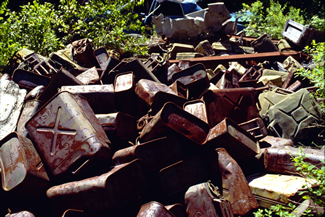Home → Spills & Site Cleanup → Programs → Federal Facilities and Superfund Programs
Federal Facilities and Superfund Programs

Introduction
The federal government is involved in all of the sites that fall under the Federal Facilities and Superfund Program umbrella. Sometimes the federal representative is the U.S. Environmental Protection Agency (USEPA) as the lead regulator for sites listed on the National Priorities or Superfund List. Sometimes the federal representative is a component of the Department of Defense (DOD), because the problems at the site are the result of past military activity. Sometimes a military facility has been placed on the Superfund list and both EPA and DOD are involved.
No matter what federal agency or agencies are involved, federal law requires that the investigation and remedial action at these sites meet state standards, criteria, regulations and guidelines. The state plays a role in remedy selection and the state is the sole regulator at most federal facilities.
Congress passed the Comprehensive Environmental Response, Compensation and Liability Act in 1980. The statute is more commonly referred to as the Superfund law. The law was written to respond to improper disposal of hazardous substances that took place before disposal of wastes was regulated. Among the many provisions of Superfund was the National Priorities List (NPL). Sites are placed on the NPL only after initial investigation indicates that federal involvement is warranted.
Since 1982, 14 Maine sites have been placed on the NPL. Twelve of these are managed by the Federal Facilities and Superfund Program. Two active Navy bases and one closed Air Force Base are listed on the NPL.
Defense Environmental Restoration Program
The Superfund law imposes requirement on the federal government, including DOD, to identify and address environmental problems for past activities at current and former military installations even when the release or potential release is not eligible for the NPL.
In addition to the former Loring Air Force Base and the active Navy bases in Kittery and Brunswick, a number of active, recently closed and transferred, and former defense facilities are scattered across Maine .
The unit coordinates the State's response to all environmental restoration activities at current and former military sites, including Formerly Utilized Defense Sites (FUDS). Restoration activities range from underground tank removals, and site assessments to corrective action, complex groundwater and soil remediation projects, community relations, negotiation of cleanup agreements, and other tasks.
Military Munitions Response Program
DOD recently began to separate its investigation, cleanup and funding efforts for closed military ranges. Ranges are very broadly defined and include pistol and rifle ranges, skeet ranges, practice bombing ranges, and areas used for testing chemical weapons. To date only minimal training and information has been available on former ranges. Congress has directed DOD to develop a list of munitions sites, including FUDS, and regulations have been drafted for reprioritizing these sites. The proposed regulations address potential hazards posed by munitions constituents and media contaminated by explosive wastes.
Contacts
For more information about the Federal Facilities and Superfund Program contact Chris Swain at 207-485-3852.
Contacts for specific sites or projects.
Laws
Department of Defense Environmental Restoration Laws
The Comprehensive Environmental Response, Compensation and Liability Act
Additional Information
- List of known remediation sites including Federal Facilities & Superfund sites
- Location of known remediation sites including Federal Facilities & Superfund sites can be found on DEP's GIS page under "Remediation Sites (Institutional Controls) Database"
- Remediation Site Documents: Until February of 2021, the Administrative Record for Remediation Sites was in paper format. DEP intends to complete the transition to an all-electronic format by January 1, 2022. During the transition, schedule a review of paper files by contacting the file room. Files that have been converted to electronic format are only available in the searchable DocuWare Portal.
- Remediation Program Guidance: Guidance for the Investigation and Clean-up of Contaminated Sites in Maine
Related Programs
Other Related Links
- EPA Federal Facilities (Military Sites)
- Department of Defense Environment, Safety and Occupational Health Network and Information Exchange
- National Superfund Homepage